Whether you class yourself as a foodie or not, it’s not hard to argue that food is a large part of experiencing local culture and an enjoyable part of travelling for many. Eating like a local by sampling specialty foods and trying regional produce is one of the easiest ways to get a feel for a new place, its history, traditions and customs.
Are you someone who likes to try local dishes when you’re away, or do you stick to what you know? Why not treat all of your senses when you visit the Galapagos islands by trying some Ecuadorian dishes. What better way to start the day than with traditional food? Academy Bay Diving has created this guide to the food in the Galapagos Islands, with a focus on the typical breakfasts that the locals know and love. If you’re a fan of fish or plantain, you won’t be disappointed!
You can expect to encounter these dishes and more if you join us for one of our Galapagos Islands Tour Packages or at any number of eateries on the islands. Keep reading to find out more about Galapagos cuisine, or feel free to contact us with any questions.
The Food of the Galapagos Islands
Bolon
 If you’re not familiar with plantain, you will quickly be introduced to it on your visit to the Galapagos islands, as it is featured in many breakfast and side dishes here. Plantain looks like a large green banana, it is grown in Ecuador and also on the local farms in the highlands of the Galapagos Islands. Plantain, also known as verde (green), is actually a fruit, but like a tomato, they are eaten and cooked as if they were a vegetable.
If you’re not familiar with plantain, you will quickly be introduced to it on your visit to the Galapagos islands, as it is featured in many breakfast and side dishes here. Plantain looks like a large green banana, it is grown in Ecuador and also on the local farms in the highlands of the Galapagos Islands. Plantain, also known as verde (green), is actually a fruit, but like a tomato, they are eaten and cooked as if they were a vegetable.
As you take a morning stroll around the towns in any of the inhabited islands, you will undoubtedly see many local Galapagueñans enjoying this local favorite. Bolon de verde is a ball shaped dumpling made from mashed green plantain that are then stuffed with cheese and/or chicharrones (pork crackling) and fried until crispy.
But that’s not all! Most traditional breakfasts that you will find in Ecuador are large and filling. This classic Ecuadorian breakfast dish is accompanied by fried egg and bistec, a classic beef stew. If you’re a vegetarian you can still join in with the locals and enjoy this breakfast, just choose the bolon “con queso” (with cheese) and “sin bistec” (without the stew). Have this for breakfast and it is sure to fill you up and give you the energy you need for your Galapagos Day Tour or Galapagos Diving Trip!
Encebollado
 Does an oniony fish soup grab your attention for something you might like to eat for breakfast? I think it’s the kind of food that one would either love or hate. If you love the sound of it, you’re in luck. Encebollado is a typical soup from the coastal region in Ecuador and you can find it across the Galapagos islands served and enjoyed for breakfast, lunch or dinner. Encebollado is made from fresh tuna, which you can be sure was sourced locally and bought in the popular fish market here in Puerto Ayora, Santa Cruz. Along with tuna, Encebollado contains yuca (cassava), tomatoes, onions, cilantro, and spices and is served with lime marinated or pickled onions and tomatoes on top or mixed in with the soup. It can come with different accompaniments, often rice or chifles – crisps made from plantains.
Does an oniony fish soup grab your attention for something you might like to eat for breakfast? I think it’s the kind of food that one would either love or hate. If you love the sound of it, you’re in luck. Encebollado is a typical soup from the coastal region in Ecuador and you can find it across the Galapagos islands served and enjoyed for breakfast, lunch or dinner. Encebollado is made from fresh tuna, which you can be sure was sourced locally and bought in the popular fish market here in Puerto Ayora, Santa Cruz. Along with tuna, Encebollado contains yuca (cassava), tomatoes, onions, cilantro, and spices and is served with lime marinated or pickled onions and tomatoes on top or mixed in with the soup. It can come with different accompaniments, often rice or chifles – crisps made from plantains.
If this doesn’t sound like an appetizing way to start your day, don’t dismiss it just yet. If you have enjoyed one (or three) too many beers at the local brewery the night before, you might want to try give Encebollado a chance. It is known as the best hangover cure and trusted by many which is why you will find a number of restaurants serving it in the early morning.
Guatita
 This one is not a meal for the faint hearted. This breakfast stew is definitely for the carnivores and more adventurous foodies amongst us. Guatita is made with tripe, the stomach lining of cow. Tripe has a chewy texture and a mild taste, taking on the flavor of the other ingredients it is cooked with, which in the case of Guatita is potatoes and peanuts.
This one is not a meal for the faint hearted. This breakfast stew is definitely for the carnivores and more adventurous foodies amongst us. Guatita is made with tripe, the stomach lining of cow. Tripe has a chewy texture and a mild taste, taking on the flavor of the other ingredients it is cooked with, which in the case of Guatita is potatoes and peanuts.
According to Healthline tripe is apparently a good source of the minerals calcium, phosphorus, magnesium and iron, rich in protein and a number of vitamins and minerals, but it’s a breakfast that packs in a lot of calories. This casserole-like meal, usually accompanied with rice, includes tripe, peanuts, peanut butter, potatoes, milk and butter along with herbs and spices, including the Ecuadorian favourite – coriander (cilantro).
Tigrillo
My personal favourite and a breakfast of champions, you can think of tigrillo like a deconstructed bolon. Tigrillo originates from the province of Loja and is enjoyed throughout Ecuador, including here in the Galapagos Islands. This popular breakfast is made with a combination of mashed green plantains, cheese, and eggs. There are some varying recipes, and some can include lard with chicharón so if you’re vegetarian you might want to check first or ask to omit that option. Tigrillo is accompanied with a fried egg or two and the classic beef steak stew, bistec.
Join Us for a Galapagos Food Tour
Don’t worry, if you’re not an adventurous eater or prefer to eat what you know then there are options for everyone here. You will be able to find continental breakfasts, simple egg dishes, sandwiches, fruit and granola and of course you can’t miss enjoying a Galapagos coffee.
Eating like a local is part of the fun when you’re on the road. But finding great eateries can be tricky. One way to undercover local gems is by joining us! We’ll show you the places recommended by locals and introduce you to some of those behind the scenes!
The Galapagos Islands have so much to offer. Of course, these Ecuadorian islands have become a dream destination for many due to the wildlife and incredible diving but why not visit and see it from all angles with us? With our new Galapagos Dives, Bites and Escapades tour you can visit different Galapagos islands, see the incredible flora and flora with land tours, dive the world-renowned dive sites as well as visit local farms, see local workers in action, take a tour of a micro-brewery, learn to cook ceviche, and sample some of these traditional breakfasts. This itinerary has it all! Feel free to contact us for more information.
Written by Charli Pocock









